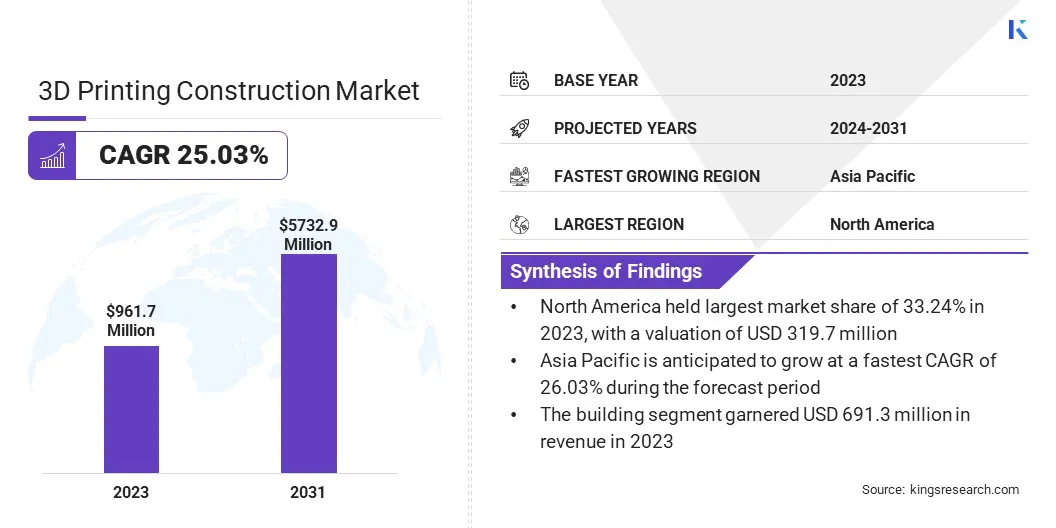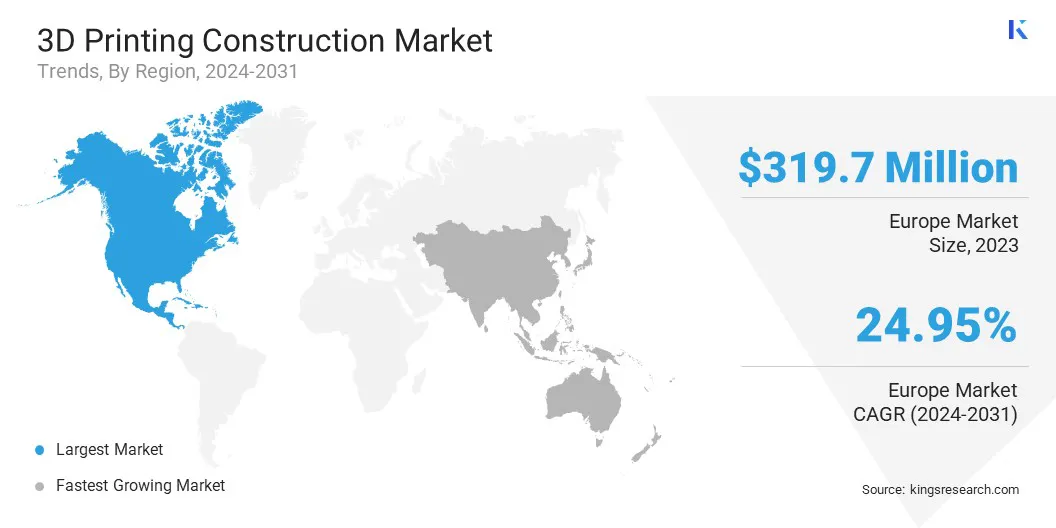Market Definition
The market utilizes additive manufacturing to create structures layer by layer using materials such as concrete, metal, or polymers.
The process, guided by digital models, enables precise, customized construction, while reducing time, costs, and material waste. This market is growing due to advancements in technology, sustainability initiaitves, and the need for affordable housing solutions.
3D Printing Construction Market Overview
Global 3D printing construction market size was USD 961.7 million in 2023, which is estimated to be valued at USD 1200.0 million in 2024 and reach USD 5732.9 million by 2031, growing at a CAGR of 25.03% from 2024 to 2031.
The rising demand for affordable housing is contributing to the growth of the market. This technology enables fast, cost-effective solutions to address housing shortages while enabling scalable and customizable developments in urban areas.
Major companies operating in the 3D printing construction industry are Apis Cor Inc., COBOD INTERNATIONAL A/S, Contour Crafting Corporation, CyBe Construction, ICON Technology, Inc., Sika AG, WASP S.r.l., XtreeE, Yingchuang Building Technique (Shanghai) Co.,Ltd. (WINSUN), D-Shape, voxeljet AG, HOLCIM, Bemore3D, Black Buffalo 3D Corporation, Branch Technology, and others.
The market is transforming the industry by enabling efficient, customized building solutions through additive manufacturing.
This innovation enhances precision, supports complex architectural designs, and fosters the use of eco-friendly materials, ultimately contributing to sustainable construction practices. With growing investment and advancements in technology, 3D printing is set to redefine construction practices and stimulate market growth.
- In January 2023, Tvasta Manufacturing Solutions completed India’s first 3D-printed office at Garden Reach Shipbuilders in Kolkata. Built in just 10 days, this 180 sq. ft. modular site office demonstrates 3D printing’s potential for rapid and sustainable large-scale construction, marking a significant milestone in India’s construction industry.

Key Highlights:
- The 3D printing construction industry size was recorded at USD 961.7 million in 2023.
- The market is projected to grow at a CAGR of 25.03% from 2024 to 2031.
- North America held a share of 33.24% in 2023, valued at USD 319.7 million.
- The mortar & concrete segment garnered USD 331.0 million in revenue in 2023.
- The extrusion segment is expected to reach USD 2207.2 million by 2031.
- The infrastructure segment is anticipated to witness the fastest CAGR of 25.07% over the forecast period
- Asia Pacific is estimated to grow at a CAGR of 26.03% through the projection period.
Market Driver
Surging Demand for Affordable Housing
Rapid urbanization is increasing the demand for affordable housing, propelling the expansion of the 3D printing construction market. According to the World Bank Group, approximately 56% of the global population currently resides in cities, a figure projected to exceed 70% by 2050 as urbanization continues.
3D printing enables faster, cost-effective construction with reduced labor requirements, reducing overall costs. Additionally, the technology allows for highly customizable designs, catering to varying housing needs in urban areas. With traditional construction struggling to meet growing demands, 3D printing is emerging as a viable, sustainable solution to housing shortages and affordability challenges.
- In May 2024, Putzmeister and STRABAG subsidiary ZÜBLIN successfully produced complete and supporting concrete walls using a 3D concrete printer for the first time. This marks a significant milestone in scalable, sustainable construction, improving efficiency, reducing emissions, and eliminating formwork,advancing eco-friendly building practices.
Market Challenge
Skilled Workforce Shortage
The shortage of skilled workers to operate advanced 3D printing systems present a significant challenge to the expansion of the 3D printing construction market. As the adoption of 3D printing technology in construction rises, there is a growing demand for specialized expertise to manage and operate these machines.
To address this, companies can invest in training programs, form partnerships with educational institutions, and foster on-the-job skill development. Additionally, automation and AI-driven systems can help reduce the reliance on manual labor, improving efficiency while mitigating skilled labor shortages.
Market Trend
Sustainable Construction Innovation
A key trend in the market is the development of sustainable, innovative building materials. These materials offer enhanced durability, reusability, and environmental benefits, supporting eco-friendly construction practices.
The focus is shifting toward reducing carbon footprints and improving the efficiency of building processes, with new technologies enabling more sustainable and versatile construction methods. This trend reflects the growing emphasis on creating resource-efficient, long-lasting, and environmentally responsible solutions within the industry.
- In September 2024, MIT engineers, in collaboration with the spinoff Evenline, developed 3D-printed, interlocking glass bricks for sustainable construction. These recyclable bricks, comparable in strength to concrete, support circular construction by enabling material use across projects, promoting eco-friendly, durable, and cost-effective building methods.
3D Printing Construction Market Report Snapshot
|
Segmentation
|
Details
|
|
By Material
|
Mortar & Concrete, Metal, Composite, Others
|
|
By Method
|
Extrusion, Powder Bonding, Spray
|
|
By End Use
|
Building, Infrastructure
|
|
By Region
|
North America: U.S., Canada, Mexico
|
|
Europe: France, UK, Spain, Germany, Italy, Russia, Rest of Europe
|
|
Asia-Pacific: China, Japan, India, Australia, ASEAN, South Korea, Rest of Asia-Pacific
|
|
Middle East & Africa: Turkey, UAE, Saudi Arabia, South Africa, Rest of Middle East & Africa
|
|
South America: Brazil, Argentina, Rest of South America
|
Market Segmentation
- By Material (Mortar & Concrete, Metal, Composite, and Others): The mortar & concrete segment earned USD 331.0 million in 2023, mainly due to its widespread use in large-scale residential and commercial projects, offering cost-effectiveness and scalability in 3D printing construction.
- By Method (Extrusion, Powder Bonding, and Spray): The extrusion segment held a share of 38.53% in 2023, largely attributed to its ability to efficiently print large structures layer by layer with precision while minimizing material waste in construction.
- By End Use (Building and Infrastructure): The building segment is projected to reach USD 4118.0 million by 2031, owing to the increasing demand for affordable housing and sustainable construction methods enabled by 3D printing technologies.
3D Printing Construction Market Regional Analysis
Based on region, the global market has been classified into North America, Europe, Asia Pacific, Middle East & Africa, and Latin America.

North America 3D printing construction industry share stood at around 33.24% in 2023, valued at USD 319.7 million. This dominance is marked by technological advancements, strong industry adoption, and substantial investments. The United States, in particular, leads in construction startups, particularly in 3D printed homes and infrastructure.
Government support, research funding, and partnerships between private companies and universities foster innovation. Additionally, the region's advanced infrastructure and construction sectors facilitate the rapid implementation and scalability of 3D printing in construction.
- In September 2024, the University of Florida acquired the BOD3, one of the largest 3D construction printers, for its East Campus. Manufactured by COBOD International, this advanced printer will be housed in the Herbert Wertheim College of Engineering’s Weil Hall for future use.
Asia Pacific 3D printing construction market is set to grow at a staggering CAGR of 26.03% over the forecast period. This growth is propelled by rapid urbanization, increasing infrastructure projects, and a growing focus on affordable housing.
Countries such as China, India, and Japan are experiencing favorable government initiatives and increased investments in 3D printing technologies.
The region’s adoption of sustainable and cost-effective construction methods, coupled with the demand for innovative building solutions, is fueling domestic market expansion. Furthermore, advancements in local manufacturing capabilities contribute to regional market growth.
- In August 2023, Kerala State Nirmithi Kendra began construction on the state's first 3D-printed structure. The project, led by Indian construction tech startup Tvasta, demonstrates advanced, sustainable, and cost-efficient building techniques.
Regulatory Frameworks
- In the U.S., the Occupational Safety and Health Administration (OSHA) ensures workplace safety through standards enforcement, training, and outreach.
- In the EU, THE Construction Products Regulation (CPR) governs the safety and performance of construction products, including those in 3D printing.
- International Organization for Standardization (ISO) standards influence the market by establishing uniform guidelines for safety, materials, and processes, ensuring quality, compliance, and global acceptance.
Competitive Landscape
The 3D printing construction industry has attracted significant investments, with companies advancing printing technology, improving material efficiency, and scaling operations.
These efforts foster innovation, enhance sustainability, reduce construction time, and address labor shortages, highlighting the sector’s potential to transform traditional construction with cost-effective, eco-friendly solutions.
- In October 2024, Amazon and Holcim co-invested in innovative startups 14Trees and Paebbl to advance sustainable 3D printing technologies. This initiative seeks to accelerate large-scale, low-carbon buildings, including data centers, while enhancing CO2 mineralization in concrete to support decarbonization efforts.
List of Key Companies in 3D Printing Construction Market:
- Apis Cor Inc.
- COBOD INTERNATIONAL A/S
- Contour Crafting Corporation
- CyBe Construction
- ICON Technology, Inc.
- Sika AG
- WASP S.r.l.
- XtreeE
- Yingchuang Building Technique (Shanghai) Co.,Ltd. (WINSUN)
- D-Shape
- voxeljet AG
- HOLCIM
- Bemore3D
- Black Buffalo 3D Corporation
- Branch Technology
Recent Developments (Partnerships/Expansion/New Product Launch)
- In August 2023, Bengaluru became home to India’s first 3D-printed post office, executed by L&T Construction using COBOD’s 3D printing technology. The project reduced construction time by 80% and costs by 40%, showcasing advancements in sustainable and efficient building practices.
- In June 2023, 3DXB Group was established in Dubai as the region's first provider of comprehensive 3D building solutions. This move aligns with Dubai's 2030 vision, aiming to revolutionize construction by implementing efficient and sustainable practices.
- In February 2025, Blackwell 3D partnered with India's National Human Resource Development Organization to advance affordable housing using 3D printing. This collaboration seeks to lower costs, minimize material waste, and accelerate construction timelines, supporting India’s housing initiatives.


